Some doctors thrive in a personality-based clinic and have a loyal following no matter what services or equipment they offer, but for most chiropractic offices who are trying to grow and expand, new equipment purchases help us stay relevant and continue to service our client base in the best, most up-to-date manner possible. So, regarding equipment purchasing: should you lease, get a bank loan, or pay cash?
Chiropractic and Golf, Part 6
Wrist and elbow pain is a common occurrence among golfers. There are two common causes: an incorrect grip on the club, or failure to set the correct incline plane of the club shaft on the downswing. Either way, these faults have the potential to create extreme mechanical strain on the muscles, tendons, ligaments and joints of the elbows and wrists. Remember, your average patient can swing the club at 90 mph. When patients play golf or go to the driving range, they will swing the club hundreds of times. If they're out of position, it's easy to be injured.
The Grip
How your patients' hands are placed on the club will have everything to do with how the wrists hinge and the right elbow folds (for the right-handed golfer) when swinging the club.
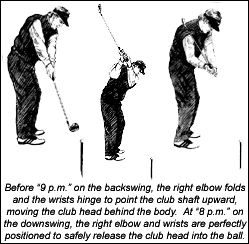
When the hands are incorrectly placed on the grip, it becomes difficult to get the club shaft into the correct upward position as the club head moves behind the body. When you're out of position at the top of the backswing, it puts a mechanical strain on the right elbow and wrists when they try to find the downward path back to the ball with the club head traveling at 90 mph.
The Incline Plane
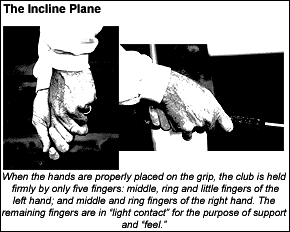
During the backswing, the club head moves upward, then behind the body. Your patient is in trouble if the club shaft is not pointing at the plane line during the downswing. The plane line is the reference for movement of the golfer's body and shaft of the golf club during the swing. The plane line extends from the golf ball to 10 feet behind the golf ball. When the club shaft points to the plane line, the club shaft is on the correct incline plane. (Note: There are 13 different incline planes, one for every club in the bag.)
The most common problem your patient will experience is when the incline plane of the club shaft becomes too steep or too flat during the downswing. Either way, your patient will flip, push, twist or turn the wrists and forearms (as a last-second correction) to get the club head to make contact with the ball. This is the root cause of a repetitive strain syndrome: being out of positional alignment, then repeatedly swinging the golf club.
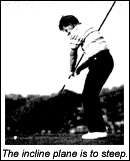
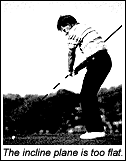
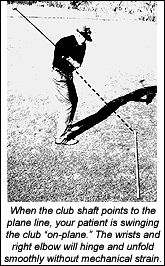
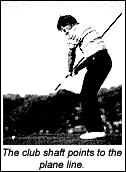
The grip: It's too complicated to explain the proper grip to any patient. Instead, go to your local golf shop and buy a grip trainer for your office. Your patients' hands will fit into the molded grooves. If they complain that it feels "weird," they probably swing the club with an incorrect grip.
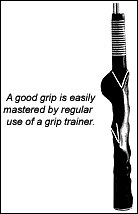
The incline plane: Using a "swing trainer," have your patient swing the club to the top of the backswing and stop. Where is the heel light pointing relative to the plane line? If the light is shining inside the line, the incline plane is too steep. If the light is shining outside the line, the incline plane is too flat.
Correction Protocol
The grip: Advise your patients to obtain a grip trainer and take 30-50 practice swings daily until the corrected grip feels natural.

Incline plane: Using the swing trainer, have your patient take repeated practice swings with different golf clubs (sand wedge through driver). Make sure the head and heel lights from the swing trainer always make contact with the plane line.
Jeffry Blanchard,DC
Encinitas, California
jhbdcpga@aol.com
www.blanchardgolf.com



